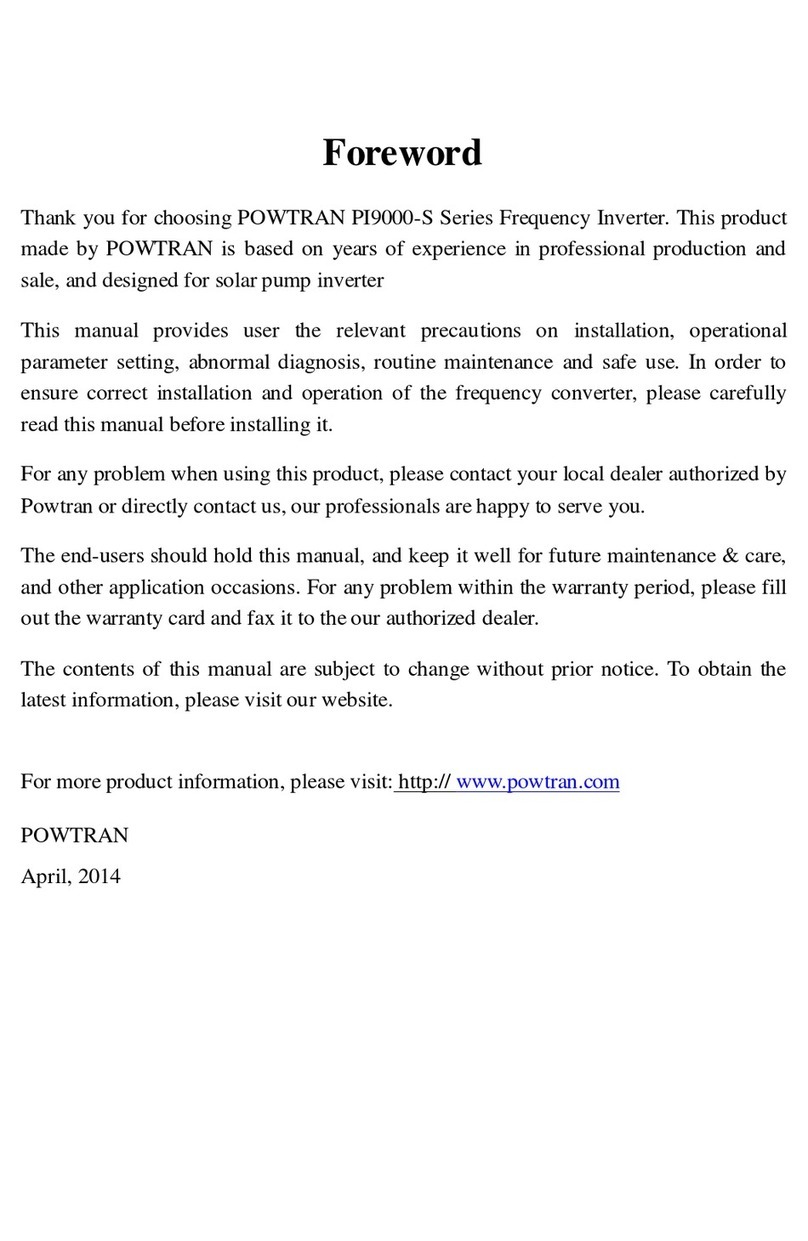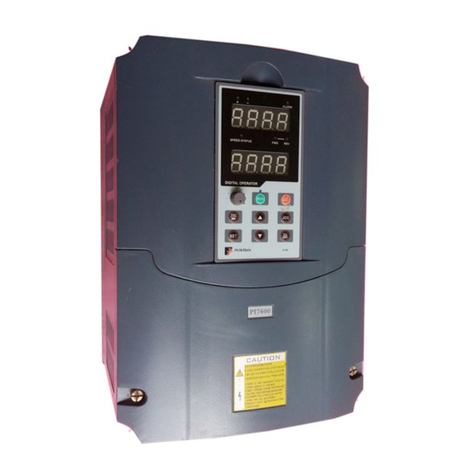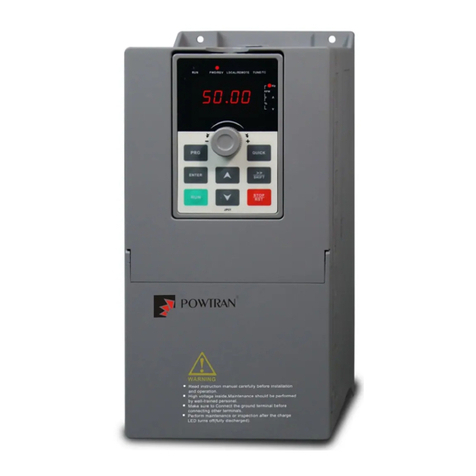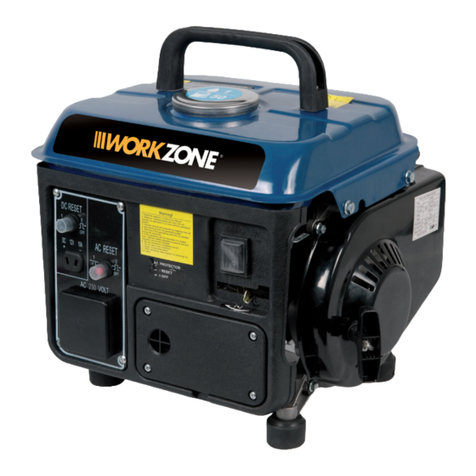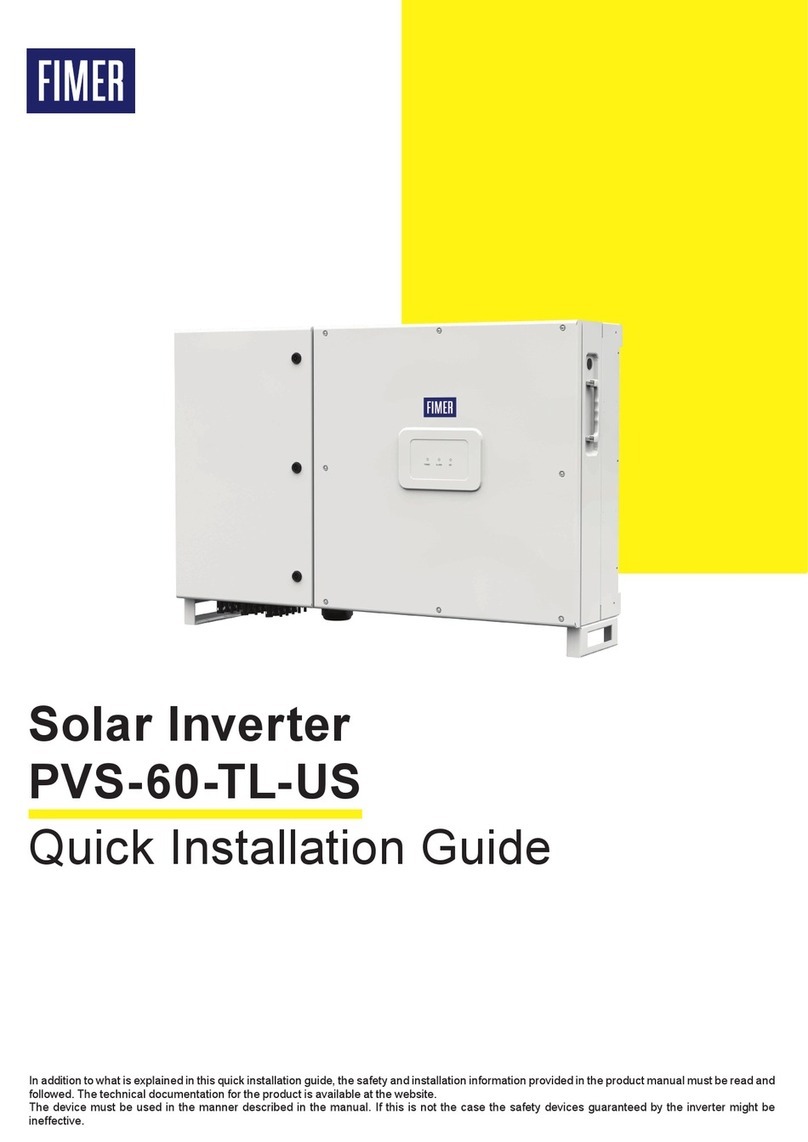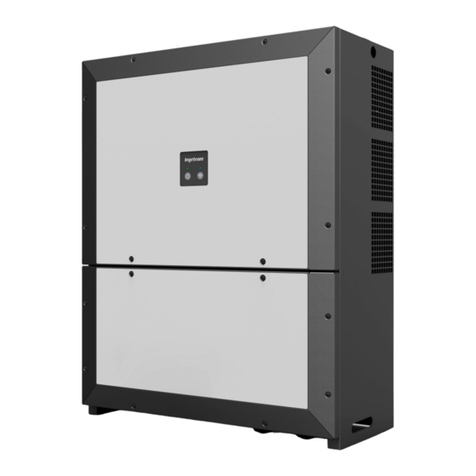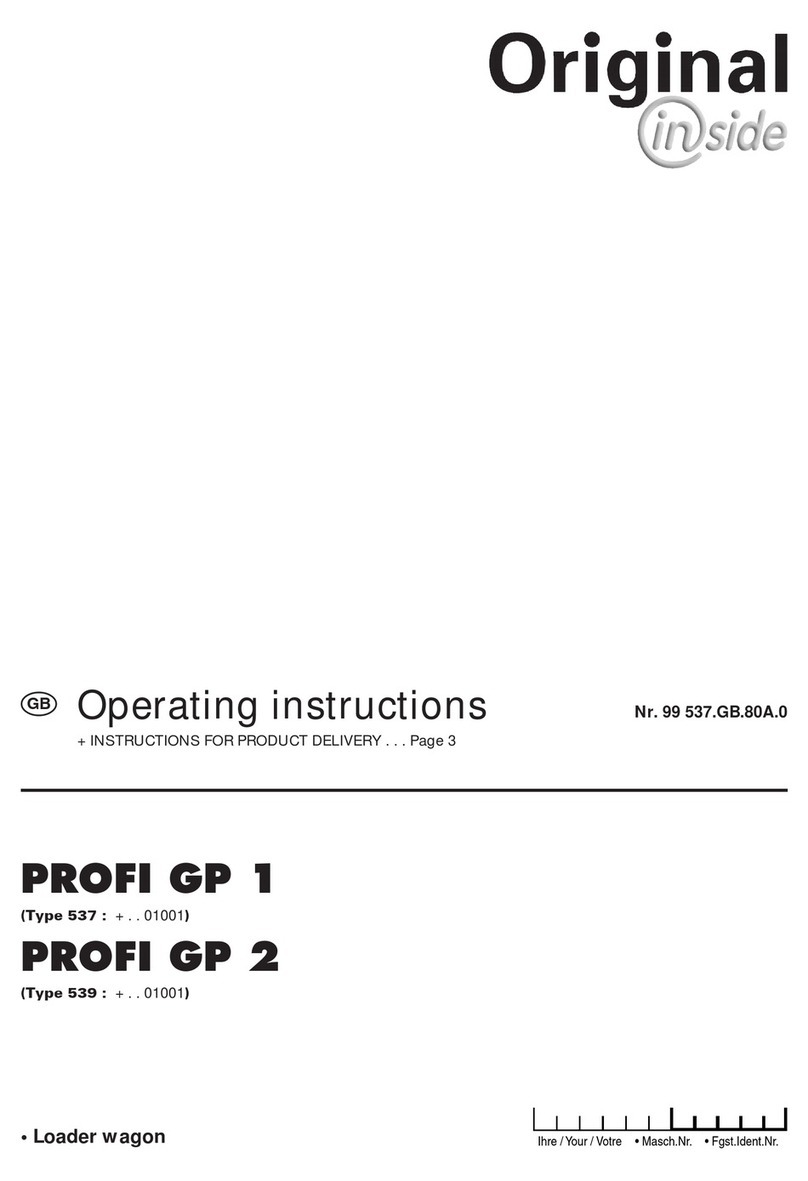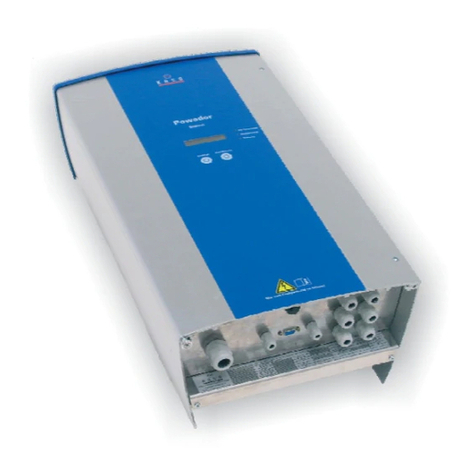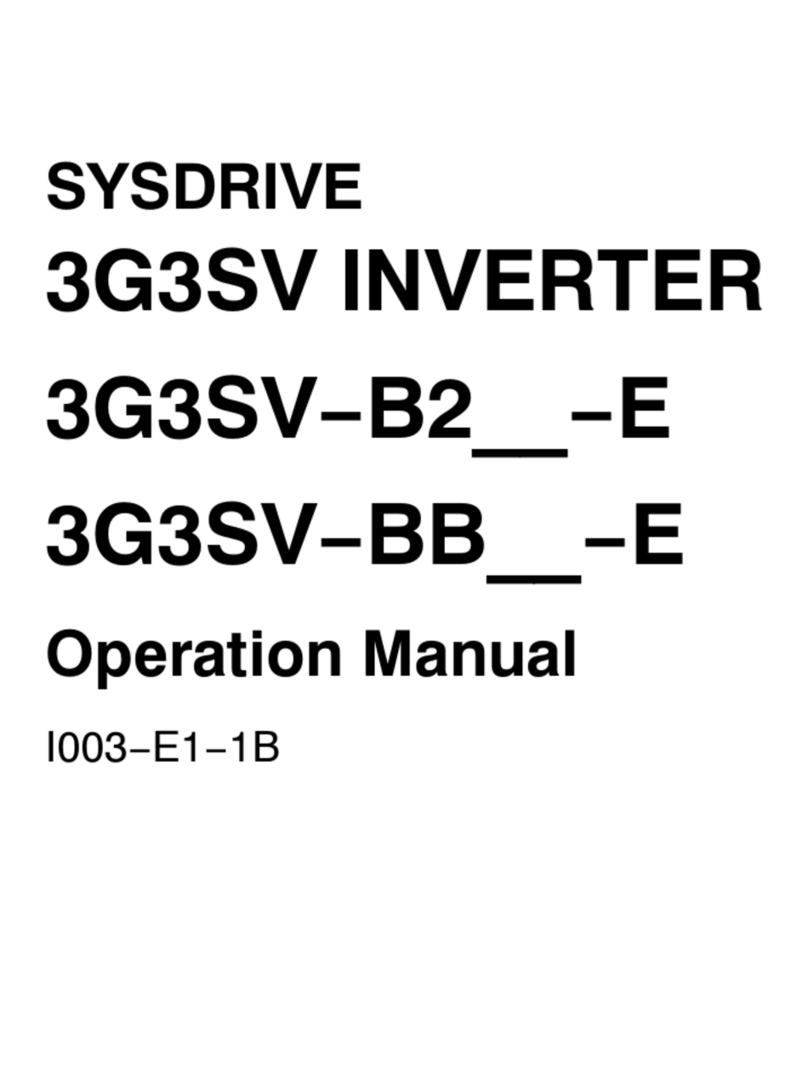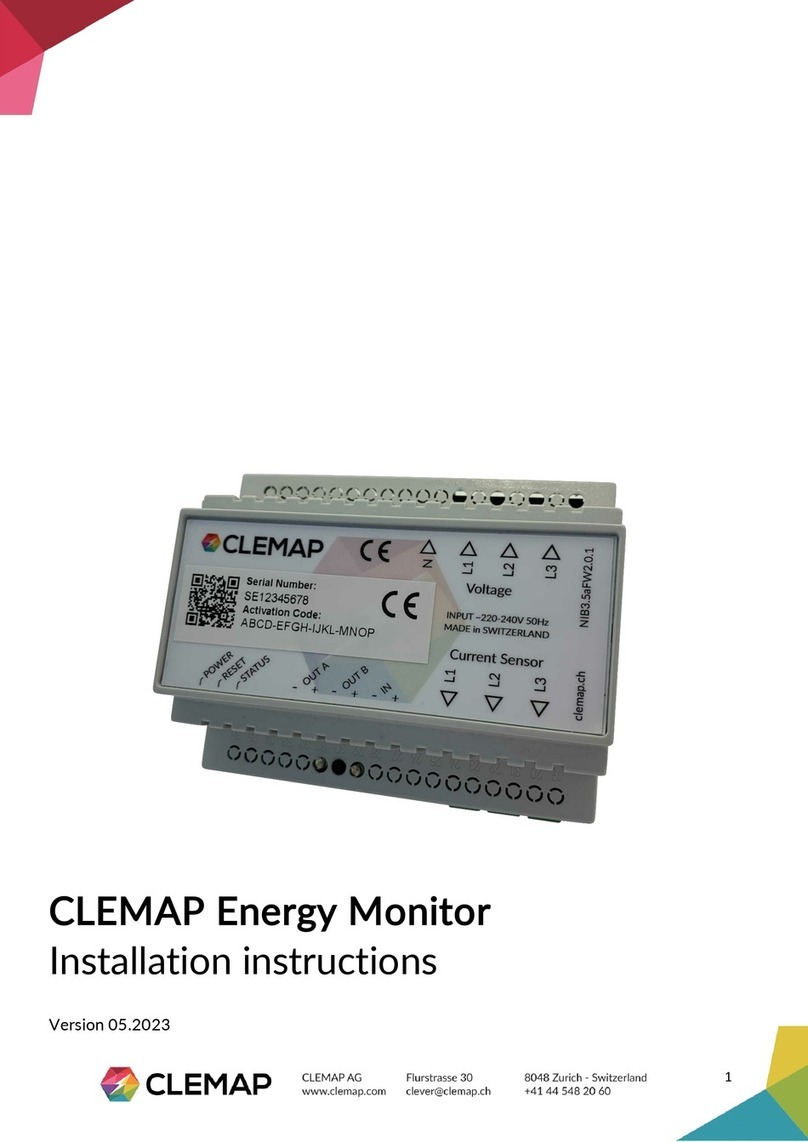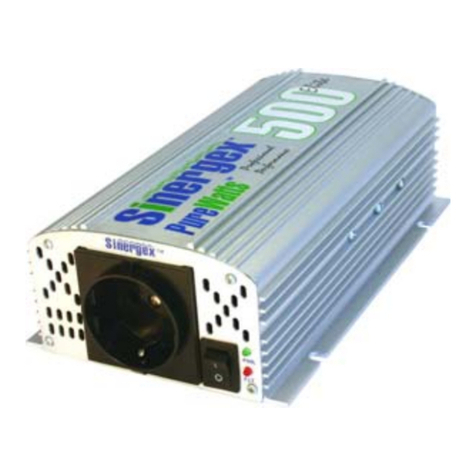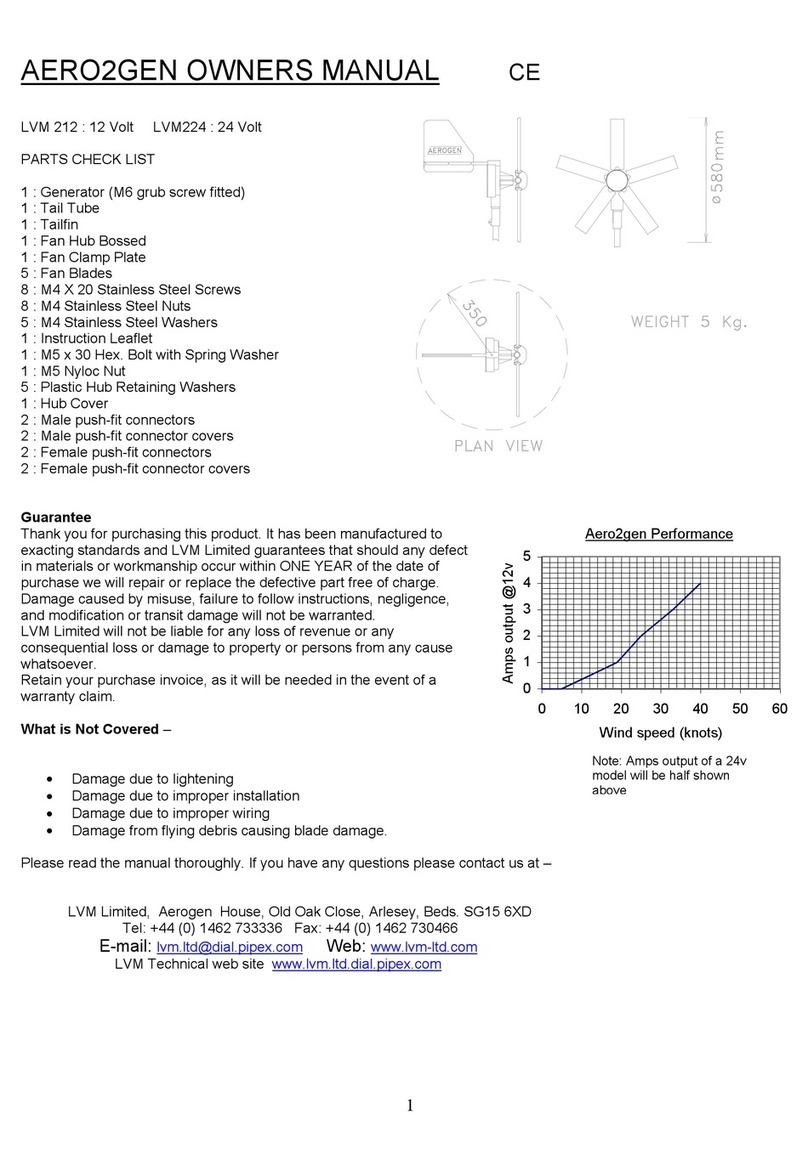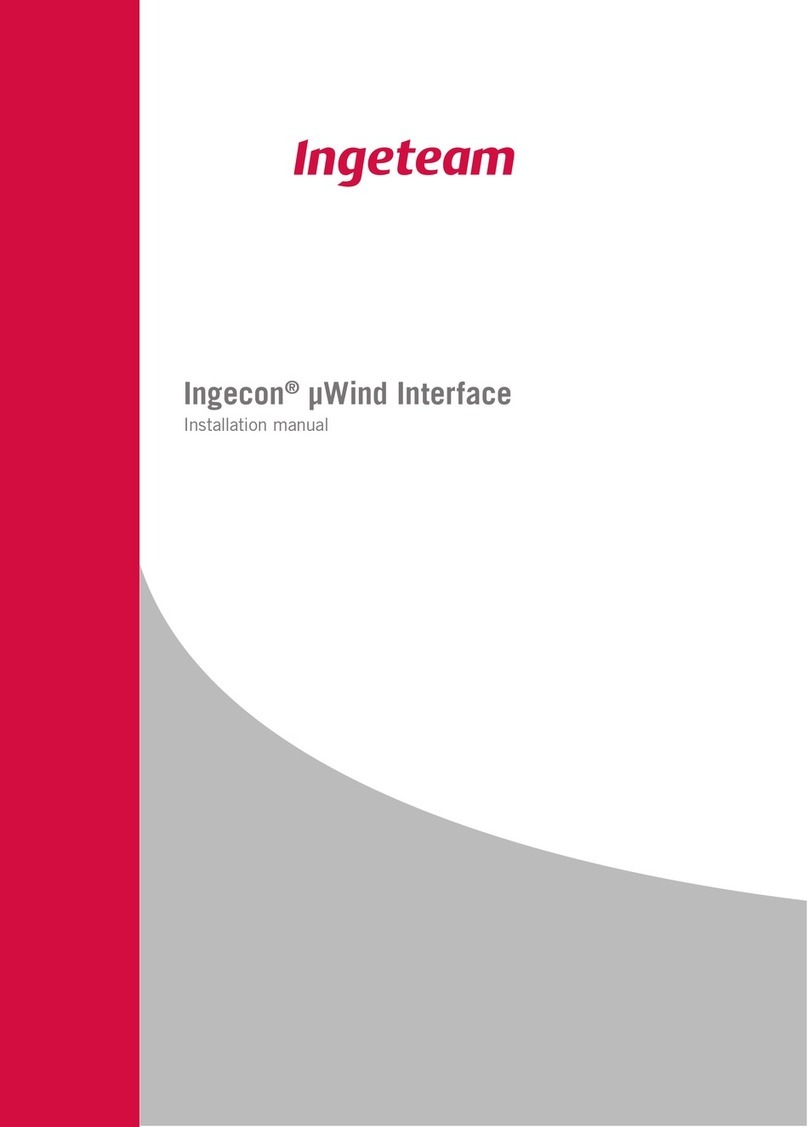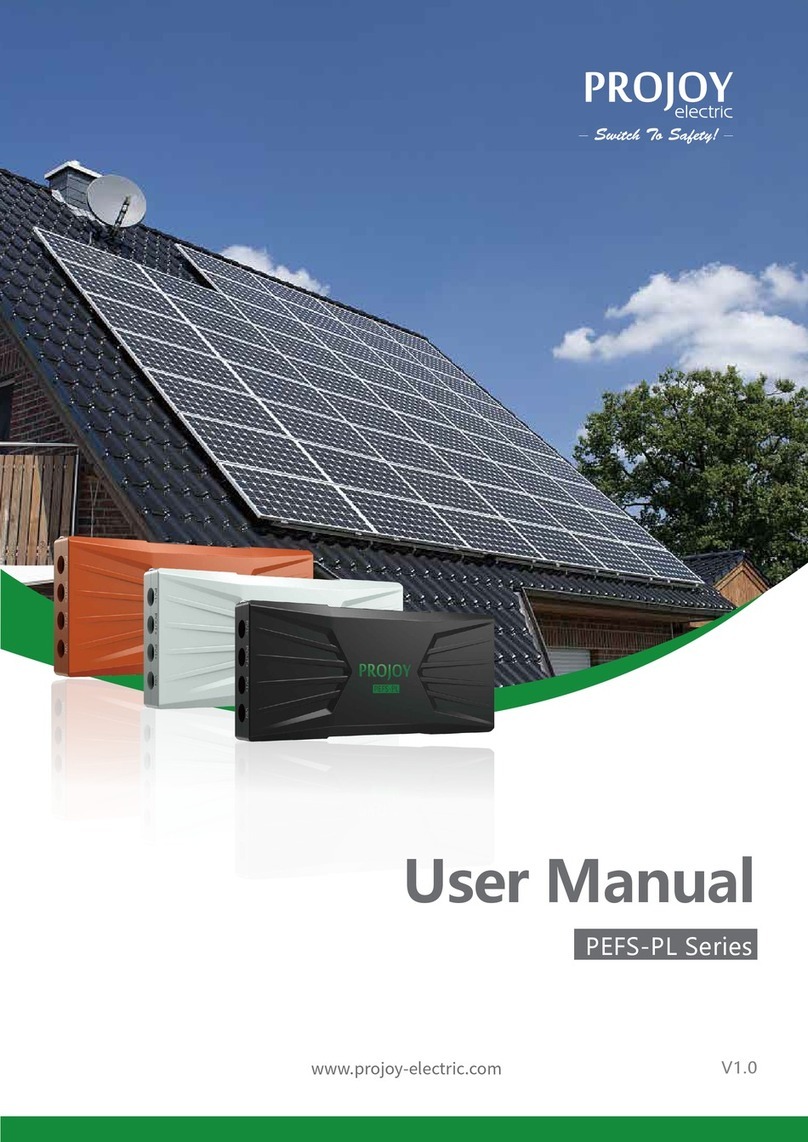Powtran PI500-E Series User manual

Foreword
Thank you for choosing POWTRAN PI500-E Series Frequency Inverter. This
product made by POWTRAN is based on years of experience in professional production
and sale, and designed for controlling and adjusting the speed and torque of three-
phase ac synchronous motor.
For any problem when using this product, please contact your local dealer
authorized by this company or directly contact this company, our professionals are
happy to serve you.
The end-users should hold this manual, and keep it well for future maintenance &
care, and other application occasions. For any problem within the warranty period,
please fill out the warranty card and fax it to the our authorized dealer.
The contents of this manual are subject to change without prior notice. To obtain
the latest information, please visit our website.
For more product information, please visit: http:// www.powtran.com.
POWTRAN
April, 2018

Contents
Chapter 1.Inspection and safety precautions......................................................1
1-1. Inspection after unpacking ..........................................................................1
1-1-1. Instructions on nameplate..................................................................1
1-1-2. Model designation .............................................................................1
1-2. Safety precautions.......................................................................................2
1-3. Precautions..................................................................................................3
1-4. Scope of applications ..................................................................................5
Chapter 2 Standard specifications......................................................................6
2-1. Technical specifications................................................................................6
2-2. Screw specification of Main loop .................................................................7
2-3. Standard specifications .................................................................................8
Chapter 3 Keyboard......................................................................................... 12
3-1. Keyboard description..................................................................................12
3-2. Keyboard indicators....................................................................................12
3-3. Description of operation panel keys............................................................13
3-4. Keyboard display letters and numbers correspondence table......................13
3-5. Example of parameter settings....................................................................14
3-5-1. Instructions on viewing and modifying function code.....................14
3-5-2. The way to read parameters in various status ..................................15
3-5-3. Password settings.............................................................................15
3-5-4. Motor parameter auto tuning ...........................................................15
Chapter 4 Installation and commissioning....................................................... 16
4-1. Installation direction and space...................................................................16
4-2. Wiring Diagram..........................................................................................17
4-3. Main circuit terminal ..................................................................................19
4-4-1. Main circuit terminal arrangement...................................................19
4-4-2. Function description of main circuit terminal..................................22
4-4. Control circuit terminals .............................................................................22
4-5-1. Control circuit terminals arrangement .............................................22
4-5-2. Description of control circuit terminals ...........................................23
4-5-3. Signal input terminal wiring diagram ..............................................24
4-5. Wiring Precautions .....................................................................................26
4-6. Commissioning...........................................................................................27
Chapter 5 Function parameter.......................................................................... 28
5-1. Menu grouping............................................................................................28
5-2. Function parameter description...................................................................54
5-2-1. Basic monitoring parameters: d0.00-d0.41......................................54
5-2-2. Basic function group: F0.00-F0.27..................................................57
5-2-3. Input terminal:F1.00-F1.46...........................................................63
5-2-4. Output terminal group:F2.00-F2.19..............................................72

3
5-2-5. Start and stop control group:F3.00-F3.15.....................................75
5-2-6. V/F control parameters: F4.00-F4.14..............................................77
5-2-7. Vector control parameters: F5.00-F5.15..........................................77
5-2-8. Keyboard and display: F6.00-F6.19................................................81
5-2-9. Auxiliary function: F7.00-F7.54......................................................84
5-2-10. Fault and protection:F8.00-F8.35..................................................91
5-2-11. Communication parameter: F9.00-F9.07.......................................96
5-2-12. Torque control parameters FA.00-FA.07 ......................................97
5-2-13. Control optimization parameters: Fb.00-Fb.09..............................98
5-2-14. Extended parameter: FC.00-FC.02................................................99
5-2-15. Wobbulate, fixed-length and counting:E0.00-E0.11 .....................99
5-2-16. Multi-stage command, simple PLC: E1.00 - E1.51.....................101
5-2-17. PID function:E2.00-E2.32........................................................104
5-2-18. Virtual DI、Virtual DO: E3.00 - E3.21 ......................................108
5-2-19. Motor parameters: b0.00-b0.35...................................................110
5-2-20. Function code management: y0.00-y0.04....................................112
5-2-21. Fault query:y1.00-y1.30..............................................................114
Chapter 6 Troubleshooting .............................................................................117
6-1. Fault alarm and countermeasures .............................................................117
6-2. EMC (Electromagnetic Compatibility).....................................................121
6-2-1. Definition......................................................................................121
6-2-2. EMC standard................................................................................121
6-3. EMC directive ..........................................................................................121
6-3-1. Harmonic effect.............................................................................122
6-3-2. Electromagnetic interference and installation precautions ............122
6-3-3. Remedies for the interference from the surrounding electromagnetic
equipment to the inverter.........................................................................122
6-3-4. Remedies for the interference from the inverter to the surrounding
electromagnetic equipment......................................................................122
6-3-5. Remedies for leakage current........................................................122
6-3-6. Precautions on installing EMC input filter at the input end of power
supply ......................................................................................................123
Chapter 7 Dimension..................................................................................... 124
7-1. Dimension ................................................................................................124
7-1-1. Product outside drawing, installation size.....................................124
7-1-2. PI500-E series ...............................................................................124
7-1-3. PI500-E Series(with DC reactor base).....................................128
7-1-4. Keypad dimension drawing...........................................................131
Chapter 8 Maintenance and repair................................................................. 132
8-1. Inspection and maintenance......................................................................132
8-2. Parts for regular replacement....................................................................132
8-3. Storage......................................................................................................133
8-4. Capacitor ..................................................................................................133
8-4-1. Capacitor rebuilt............................................................................133
8-5. Measuring and readings............................................................................134

Chapter 9 Options ..........................................................................................135
9-1. Expansion cards........................................................................................136
9-2. AC input reactor .......................................................................................136
9-2-1. AC Input Reactor...........................................................................136
9-3. AC output reactor......................................................................................137
9-3-1.AC output reactor ...........................................................................137
9-4. DC reactor.................................................................................................138
9-5. Input filter.................................................................................................139
9-6. Output filter ..............................................................................................140
9-7. Brake unit and brake resistor ....................................................................140
9-8. Main Circuit Breaker (MCCB), Contactor, Wire......................................144
Chapter 10 Warranty ......................................................................................147
Appendix I RS485 Communication protocol.................................................148
I-1 Communication protocol.........................................................................148
Appendix II How to use universal encoder expansion card...........................157
Appendix III CAN bus communication card use description ........................159
Appendix IV: Instruction of Profibus –DP communication card ................... 160

1
第
十
章
Chapter 1
Chapter 1.Inspection and safety precautions
POWTRAN frequency inverters have been tested and inspected before leaving factory. After
purchasing, please check if its package is damaged due to careless transportation, and if the
specifications and model of the product are consistent with your order requirements. For any problem,
please contact your local authorized POWTRAN dealer or directly contact this company.
1-1.Inspection after unpacking
※Check if that packing container contains this unit, one manual and one warranty card。
※Check the nameplate on the side of the frequency inverter to ensure that the product you
have received is right the one you ordered。
1-1-1.Instructions on nameplate
*Input Source Spec.
*Output Power Spec.
*Production Sequence
Number
*Inverter model
POWER
INPUT
OUTPUT
DALIAN POWTRAN TECHNOLOGY CO.,LTD.
MODEL
45kW
AC 3PH 380V(-15%) ~440V(+10%) 50Hz/60Hz
AC 3PH 0V~Vin 90A 0~400Hz
PI500-E 045G3
ZPB1A8888888
*Output Spec.
*Bar code
*Production Address
Figure1-1:Nameplate Description
1-1-2.Model designation
POWTRAN Inverter
Rated output capacity
045:45kW
132:132kW
Function code
G: Standard load
Series Code
PI500 Series Input Voltage Level
1: Single-phase 220V
2: Three-phase 220V
3: Three-phase 380V
Code with DC reactance
R: with DC reactor
(don't write without DC reactance)
Dedicated permanent magnet
synchronous machine
Figure 1-2:Model Description

Chapter 1.Inspection and safety precautions
2
Chapter 1
1-2.Safety precautions
Safety precautions in this manual are divided into the following two categories:
Danger: the dangers caused by failure to perform required operation, may result in
serious injury or even death;
Caution:the dangers caused by failure to perform required operation, may result in
moderate injury or minor injury, and equipment damage;
Proc
ess
Type
Explanation
Before
installa
tion
Danger
●When unpacking, if control system with water, parts missed or component
damaged are found, do not install!
●If packing list does not match the real name, do not install!
Note
●When carrying the inverter, be sure to hold on the housing. If grab the
front cover, the main body of inverter may fall down and there is the risk of
damage to the equipment.
●Gently carry with care, otherwise there is the risk of damage to equipment.
●Please do not use the damaged driver or the frequency inverter with missed
pieces, otherwise there is the risk of injury.
●This device has passed the withstand voltage test before leaving factory,do
not test any parts of the inverter . High voltage may lead to damage to the
inverter insulation and internal parts.
When
installi
ng
Danger
●Do not modify the inverter .The modified inverter may has risk of electric
shock . We shall not take any responsibility if your company or your
customer has modified the product.
●Never twist the mounting bolts of the equipment components, especially
the bolt with mark!
Note
●Non-electrical construction professionals are not allowed to install,
maintain, inspect or replace parts.Otherwise there is a risk of electric shock.
●Encoder must use the shielded wire, and the shielding layer must ensure
the single-ended grounded!
●Do not install transformers or other devices that generate electromagnetic
waves or interference around the inverter, otherwise it will lead to the
wrong operation of the inverter . if need to install such kind of device , a
shield plate shall be set between the device and the inverter .
When
wiring
Danger
●Do not connect the wire when power on , otherwise there is a risk of
electric shock. Please cut off the power of all equipment before checking.
Even though the power is cut off , there is residual voltage in the internal
capacitor. Please wait at least 10 minutes after power off.
●The contact current of inverter over than 3.5mA, please ensure the
grounding of inverter is good . Otherwise there is a risk of electric shock.
Note
●Please connect the output terminal U,V,W of inverter to the input terminal
U,V,W of motor. Be sure the motor terminals and inverter terminals are in
same phase sequence. If the phase sequence is different , it will cause the
motor to rotate in reverse.
●Do not connect the power to the output terminal of inverter, otherwise it
will damage the inverter , even cause fire.
●In some systems , the machine may start suddenly when power on, there is
a risk of death or injury.
●Before switching on the inverter power , please make sure the cover plate
of inverter is firmly installed , and the motor is allowed to restart . Make
sure the rated voltage of inverter is consistent with the power supply
voltage.
●If the main circuit power voltage is used incorrectly, there will be a

Chapter 1.Inspection and safety precautions
3
Chapter 1
danger of fire.
●Do not connect the input power source to the output terminals (U,V,W) of
inverter . Otherwise there is a risk of damage to inverter.
After
energiz
ing
Danger
● Do not open cover plate after energizing. Otherwise there is a risk of
electric shock!
●Do not touch any input and output terminals of the inverter. Otherwise
there is a risk of electric shock!
●Do not remove the cover of inverter or touch the printed circuit board
when it is power on , otherwise there is a risk of electric shock!
Note
●Please do not change the inverter manufacturer parameters. Otherwise it
may cause damage to this unit!
●If you need to identify the parameters, please pay attention to the danger
of injury during motor rotation. Otherwise it may cause an accident!
During
operati
on
Danger
●Do not touch the cooling fan and the discharge resistor to feel the
temperature. Otherwise it may cause burns!
●Non-professional personnel is not allowed to detect signal when operating.
Doing so may cause personal injury or damage to this unit!
Note
●When the inverter is operating, you should avoid that objects fall into this
unit.Otherwise cause damage to this unit!
●Do not start/stop the driver by switching on/off contactor. Otherwise cause
damage to this unit!
When
maintai
ning
Danger
● Do not perform repairs and maintenance for the live electrical equipment.
Otherwise there is a risk of electric shock!
● The repairs and maintenance task can be performed only when the
inverter bus voltage is lower than 36V,Otherwise, the residual charge from
capacitor would cause personal injury!
● Non-well-trained professional personnel is not allowed to perform repairs
and maintenance of inverter. Doing this may cause personal injury or
damage to this unit!
●After replacing the inverter, parameter settings must be redone, all
pluggable plugs can be operated only in the case of powering off!
●Do not power on and operate the damaged inverter, otherwise it will
enlarge the damage.
1-3.Precautions
No.
Type
Explanation
1
Motor insulation
inspection
Please perform motor insulation inspection for the first time use, re-
use after leaving unused for a long time as well as regular check, in
order to prevent damage to the inverter because of the motor's
winding insulation failure. Wiring between motor and inverter shall
be disconnected, it is recommended that the 500V voltage type
megger should be adopted and insulation resistance shall be not less
than 5MΩ.
2
Motor thermal
protection
If the rated capacity of the selected motor does not match the
inverter, especially when the inverter rated power is greater than the
motor rated power, be sure to adjust the motor protection parameter
values inside inverter or install thermal relay in the front of motor for
motor protection.
3
Run over power
frequency
The inverter output frequency rang is 0Hz to 500Hz. If the user is
required to run at 50Hz or more, please consider the endurance of
your mechanical devices.
4
Vibrations of
mechanical device
Inverter output frequency may be encountered mechanical resonance
point of the load device, you can set jump frequency parameter inside
inverter to avoid the case.

Chapter 1.Inspection and safety precautions
4
Chapter 1
5
Motor heat and
noise
The inverter output voltage is PWM wave that contains a certain
amount of harmonics, so the temperature rise, noise and vibration of
motor show a slight higher than frequency power frequency
operation.
6
Output side with
piezoresistor or
capacitor for
proving power
factor
The inverter output is PWM wave, if the piezoresistor for lightning
protection or the capacitor for improving power factor is installed in
the output side, which easily cause the inverter instantaneous
overcurrent or even cause damage to the inverter. Please do not use.
7
Contactor or
switch used in the
inverter
input/output
terminals
If contactor is installed between power supply and inverter, the
contactor is not allowed to start/stop the inverter. Necessarily need to
use the contactor to control the inverter start/stop, the interval should
not be less than one hour. Frequent charging and discharging may
reduce the service life of the inverter capacitor. If the contactor or
switch is equipped between output terminals and motor, the inverter
should be turned on/off without output status, otherwise which easily
lead to damage to the inverter module.
8
Use other than the
ratedvoltage
PI series inverter is not suitable for use beyond the allowable
operating voltage described in this manual, which easily cause
damage to the parts inside inverter. If necessary, please use the
corresponding transformer to change voltage.
9
Never change 3-
phase input to 2-
phase input
Never change PI series 3-phase inverter to 2-phase one for
application. Otherwise it will lead to malfunction or damage to the
inverter.
10
Lightning surge
protection
The series inverter is equipped with lightning overcurrent protection
device, so it has the ability of self-protection to lightning induction.
For the area where lightning is frequent, user should also install the
extra protection in the front of the inverter.
11
High altitude and
derating
application
When the inverter is used in areas over 1000m altitude, it is required
to reduce frequency because the thin air will decrease the cooling
effect of inverter. Please consult our technician for details on the
application.
12
Special use
If the user need to use methods other than the suggested wiring
diagram provided in this manual, such as common DC bus, please
consult our technician.
13
Precautions for
scrap disposal of
the inverter
When electrolytic capacitors on the main circuit and printed circuit
board as well as plastic parts are burned, it may produce toxic
gases.Please disposing as industrial waste.
14
Adaptive motor
1) Standard adaptive motor shall be permanent magnet synchronous
motor , please select the inverter according to the motor rated current.
2) The cooling fan and the rotor shaft for non-inverter motor are
coaxially connected, the fan cooling effect is reduced when the
rotational speed is reduced, therefore, when the motor works in
overheating occasions, a strong exhaust fan should be retrofitted or
replace non-inverter motor with the inverter motor.
3) The inverter has built-in the adaptive motor standard parameters,
according to the actual situation, please identify motor parameters or
accordingly modify the default values to try to meet the actual value,
otherwise it will operation affect and protection performance;
4) When short-circuit of cable or motor internal will activate the
inverter alarm, even bombing. Therefore, firstly perform insulation
short-circuit test for the initial installation of the motor and cable,
routine maintenance often also need to perform such test. Note that
the parts to be tested and the inverter shall be disconnected

Chapter 1.Inspection and safety precautions
5
Chapter 1
completely when testing.
15
Others
1)We need to fix cover and lock before power on, so as to avoid the
harm to personal safety that is caused by internal injuries of bad
capacitors and other components.
2)Do not touch internal circuit board and any parts after powering off
and within five minutes after keyboard indicator lamp goes out, you
must use the instrument to confirm that internal capacitor has been
discharged fully, otherwise there is a danger of electric shock.
3)Body static electricity will seriously damage the internal MOS field-
effect transistors, etc., if there are not anti-static measures, do not
touch the printed circuit board and IGBT internal device with hand,
otherwise it may cause a malfunction.
4)The ground terminal of the inverter(E or ) shall be earthed firmly
according to the provisions of the National Electrical Safety and other
relevant standards. Do not shut down(power off) by pulling switch,
and only cut off the power until the motor stopping operation.
5)It is required to add the optional input filter attachment so as to meet
CE standards.
1-4.Scope of applications
※This inverter is suitable for three-phase permanent magnet synchronous motor.
※This inverter can only be used in those occasions recognized by this company, an
unapproved use may result in fire, electric shock, explosion and other accidents.
※If the inverter is used in such equipment (e.g: equipment for lifting persons, aviation systems,
safety equipment, etc.) and its malfunction may result in personal injury or even death. In
this case, please consult the manufacturer for your application.
Only the well-trained personnel can be allowed to operate this unit, please carefully read the
instre1tions on safety, installation, operation and maintenance before use. The safe operation
of this unit depends on proper transport, installation, operation and maintenance!

6
第
十
章
Chapter 2
Chapter 2 Standard specifications
2-1.Technical specifications
Model
Rated output
power (kW)
Rated input
current (A)
Rated
output
current (A)
Adaptive
motor
(kW)
AC 1PH 220V(-15%)~240V(+10%)
PI500-E 0R4G1
0.4
5.4
2.5
0.4
PI500-E 0R7G1
0.75
8.2
4
0.75
PI500-E 1R5G1
1.5
14
7
1.5
PI500-E 2R2G1
2.2
23
10
2.2
PI500-E 004G1
4.0
35
16
4.0
PI500-E 5R5G1
5.5
50
25
5.5
AC 3PH 220V(-15%)~240V(+10%)
PI500-E 0R4G2
0.4
4.1
2.5
0.4
PI500-E 0R7G2
0.75
5.3
4
0.75
PI500-E 1R5G2
1.5
8.0
7
1.5
PI500-E 2R2G2
2.2
11.8
10
2.2
PI500-E 004G2
4.0
18.1
16
4
PI500-E 7R5G2
7.5
37.1
32
7.5
PI500-E 011G2
11
49.8
45
11
PI500-E 015G2
15.0
65.4
60
15.0
PI500-E 018G2
18.5
81.6
75
18.5
PI500-E 022G2
22.0
97.7
90
22.0
PI500-E 030G2
30.0
122.1
110
30.0
PI500-E 037G2
37.0
157.4
152
37.0
PI500-E 045G2
45.0
185.3
176
45.0
PI500-E 055G2
55.0
214
210
55.0
PI500-E 075G2
75
307
304
75
AC 3PH 380V(-15%)~440V(+10%)
PI500-E 0R7G3
0.75
4.3
2.1
0.75
PI500-E 1R5G3
1.5
5.0
3.8
1.5
PI500-E 2R2G3
2.2
5.8
5.1
2.2
PI500-E 004G3
4.0
10.5
9
4.0
PI500-E 5R5G3
5.5
14.6
13
5.5
PI500-E 7R5G3
7.5
20.5
17
7.5
PI500-E 011G3
11
26
25
11
PI500-E 015G3
15
35
32
15
PI500-E 018G3
18.5
38.5
37
18.5
PI500-E 022G3
22
46.5
45
22
PI500-E 030G3
30
62
60
30
PI500-E 037G3
37
76
75
37

Chapter 2 Standard specifications
7
Chapter 2
Model
Rated output
power (kW)
Rated input
current (A)
Rated
output
current (A)
Adaptive
motor
(kW)
PI500-E 045G3
45
91
90
45
PI500-E 055G3
55
112
110
55
PI500-E 075G3
75
157
152
75
PI500-E 090G3
90
180
176
93
PI500-E 110G3
110
214
210
110
PI500-E 132G3
132
256
253
132
PI500-E 160G3
160
307
304
160
PI500-E 200G3
200
385
380
200
PI500-E 220G3
220
430
426
220
PI500-E 250G3
250
468
465
250
PI500-E 280G3
280
525
520
280
PI500-E 315G3
315
590
585
315
PI500-E 355G3
355
665
650
355
PI500-E 400G3
400
785
725
400
PI500-E 450G3R
450
883
820
450
Note:(1)PI500-E series inverter PI500-E 132G3~PI500-E 450G3 ended with “R”refers to
with built-in DC reactor, such as PI500-E 160G3R , PI500-E 160G4R.
(2)Correct selection method of inverter is : inverter rated output current , motor rated current ,
and consider the overload capacity.Usually rated power difference between inverter and motor is
recommended not exceed 2 power segments .When use big inverter to drive small motor , motor
parameters must be input correctly to avoid of damage which caused by motor overload.
2-2.Screw specification of Main loop
Model
Screw specification
Fastening torque(Nm)
PI500-E 0R7G1
M3
0.5~0.7
PI500-E 0R7G2
M3
0.5~0.7
PI500-E 0R7G3
M3
0.5~0.7
PI500-E 1R5G2
M3
0.5~0.7
PI500-E 1R5G3
M3
0.5~0.7
PI500-E 2R2G3
M3
0.5~0.7
PI500-E 1R5G1
M3
0.5~0.7
PI500-E 2R2G1
M3
0.5~0.7
PI500-E 2R2G2
M3
0.5~0.7
PI500-E 3R7G3
M3
0.5~0.7
PI500-E 3R7G1
M4
1.2~1.5
PI500-E 3R7G2
M4
1.2~1.5
PI500-E 5R5G2
M4
1.2~1.5
PI500-E 5R5G3
M4
1.2~1.5
PI500-E 7R5G3
M4
1.2~1.5
PI500-E 011G3
M4
1.2~1.5

Chapter 2 Standard specifications
8
Chapter 2
PI500-E 5R5G1
M5
2~2.5
PI500-E 7R5G2
M5
2~2.5
PI500-E 015G3
M5
2~2.5
PI500-E 011G2
M5
2~2.5
PI500-E 018G3
M5
2~2.5
PI500-E 022G3
M5
2~2.5
PI500-E 015G2
M6
4~6
PI500-E 018G2
M6
4~6
PI500-E 030G3
M6
4~6
PI500-E 037G3
M6
4~6
PI500-E 022G2
M8
9~11
PI500-E 030G2
M8
9~11
PI500-E 037G2
M8
9~11
PI500-E 045G3
M8
9~11
PI500-E 055G3
M8
9~11
PI500-E 075G3
M8
9~11
PI500-E 045G2
M10
18~23
PI500-E 055G2
M10
18~23
PI500-E 090G3
M10
18~23
PI500-E 110G3
M10
18~23
PI500-E 075G2
M10
18~23
PI500-E 132G3
M10
18~23
PI500-E 160G3
M10
18~23
PI500-E 200G3
M10
18~23
PI500-E 220G3
M10
18~23
PI500-E 250G3
M12
32~40
PI500-E 280G3
M12
32~40
PI500-E 315G3
M12
32~40
PI500-E 355G3
M12
32~40
PI500-E 400G3
M12
32~40
PI500-E 450G3R
M12
32~40
2-3.Standard specifications
Items
Specifications
Power
Input
Rated voltage
AC 1PH 220V(-15%)~240V(+10%)
AC 3PH 220V(-15%)~240V(+10%)
AC 3PH 380V(-15%)~440V(+10%)
Input frequency
50Hz/60Hz
Allowing
fluctuations
Voltage continued
volatility:±10%
Less than 3% of voltage unbalance
rate 3%;
Input frequency fluctuation:
Distortion satisfy IEC61800-2

Chapter 2 Standard specifications
9
Chapter 2
±5%;
standard
Control system
Control system
High performance vector control inverter based on DSP
Control
method
V/F control( for factory debugging use),vector control W/O
PG,vector control W/PG
Acceleration/dec
eleration control
Straight or S-curve mode. Four times available and time range is 0.0
to 6500.0s.
Over load
capability
G type:rated current 150%-1min, rated current 180%-2s;
Maximum
frequency
1、Vector control:0~500Hz;
Carrier
Frequency
2~16kHz;automatically adjust carrier frequency according to the load
characteristics.
Input frequency
resolution
Digital setting:0.01Hz Minimum analog:0.01Hz
Start torque
Vector control W/O PG:2% rated speed 100% rated torque
Vector control W/PG:0Hz/180% rated torque
Speed range
1:50( vector control W/O PG)1:1000(vector control W/PG)
Steady-speed
precision
Vector control W/O PG: ≤ ± 0.1% (rated synchronous speed)
Vector control W/ PG: ≤ ± 0.02% (rated synchronous speed)
Torque response
≤ 40ms (vector control W/O PG)
Jogging control
Jog Frequency Range: 0.00Hz to max. frequency;
Jog Ac/deceleration time: 0.0s to 6500.0s
Multi-speed
operation
Achieve up to 16-speed operation through the control terminal
Built-in PID
Easy to realize closed-loop control system for the process control.
Automatic
voltage
regulation(AVR)
Automatically maintain a constant output voltage when the voltage of
electricity grid changes
Torque limit and
control
"Excavator" feature - torque is automatically limited during the
operation to prevent frequent overcurrent trip; the closed-loop vector
mode is used to control torque.
Personalization
function
Self-inspection
of peripherals
after power-on
After powering on, peripheral equipment will perform safety testing,
such as ground, short circuit, etc.
Quick current
limiting
The current limiting algorithm is used to reduce the inverter over current
probability, and improve whole unit anti-interference capability.
Timing
control
Timing control function: time setting range(0m to 6500min)
Running
Input signal
Running method
Keyboard/terminal/communication
Frequency
setting
10 frequency settings available, including adjustable DC(0 to
10V), adjustable DC(0 to 20mA), panel potentiometer, etc.
Start signal
Rotate forward/reverse
Multi-speed
At most 16-speed can be set(run by using the multi-function
terminals or program)
Emergency stop
Interrupt controller output
Wobbulate run
Process control run
Fault reset
When the protection function is active, you can automatically or
manually reset the fault condition.
PID feedback
signal
Including DC(0 to 10V), DC(0 to 20mA)

Chapter 2 Standard specifications
10
Chapter 2
Output Signal
Running
status
Motor status display, stop, ac/deceleration, constant speed, program
running status.
Fault output
Contact capacity :normally closed contact 3A/AC 250V,normally
open contact5A/AC 250V,1A/DC 30V.
Analog output
Two-way analog output, 16 signals can be selected such as
frequency, current, voltage and other, output signal range (0 to 10V /
0 to 20mA).
Output signal
At most 4-way output, there are 40 signals each way
Run function
Limit frequency, jump frequency, frequency compensation, auto-tuning,
PID control
Running
command
channel
Three channels: operation panel, control terminals and serial
communication port. They can be switched through a variety of ways.
Frequency
source
Total 10 frequency sources: digital, analog voltage, analog current,
multi-speed and serial port. They can be switched through a variety of
ways.
Input terminals
8 digital input terminals, compatible with active PNP or NPN input
mode, one of them can be for high-speed pulse input(0 to 100 kHz
square wave); 3 analog input terminals for voltage or current input.
Output terminals
2 digital output terminals, one of them can be for high-speed pulse
output(0 to 100kHz square wave); one relay output terminal; 2 analog
output terminals respectively for optional range (0 to 20mAor 0 to
10V), they can be used to set frequency, output frequency, speed and
other physical parameters.
Protection function
Inverter
protection
Overvoltage protection, undervoltage protection, overcurrent
protection, overload protection, overheat protection, overcurrent stall
protection, overvoltage stall protection, losting-phase protection
(optional), communication error, PID feedback signal abnormalities,
PG failure and short circuit to ground protection.
IGBT
temperature
display
Displays current temperature IGBT
Inverter fan
control
Can be set
Parameter
protection
function
Protect inverter parameters by setting administrator Password and
decoding
Display
LED/O
LED
display
keyboar
d
Runnin
g
informa
tion
Monitoring objects including: running frequency, set frequency, bus
voltage, output voltage, output current, output power, output torque,
input terminal status, output terminal status, analogAI1 value, analog
AI2 value, motor Actual running speed,PID set value percentage,
PID feedback value percentage.
Error
messag
e
At most save three error message, and the time, type, voltage,
current, frequency and work status can be queried when the failure is
occurred.
LED display
Display parameters
OLED display
Optional, prompts operation content in Chinese/English text.
Copy parameter
Can upload and download function code information of frequency
converter, rapid replication parameters.
Key lock and
function
Lock part or all of keys, define the function scope of some keys to
prevent misuse.

Chapter 2 Standard specifications
11
Chapter 2
selection
Co
m
mu
nic
ati
on
RS485
Built-in 485
Environment
Product standard
Environment
temperature
-10℃to 40℃(temperature at 40 ℃to 50℃, please derating for use)
Storage
temperature
-20 ℃to 65 ℃
Environment
humidity
Less than 90% R.H, no condensation.
Vibration
Below 5.9m/s²(= 0.6g)
Application sites
Indoor where no sunlight or corrosive, explosive gas and water vapor,
dust, flammable gas,oil mist, water vapor, drip or salt, etc.
Altitude
It is normally used when altitude less than 1000m. For areas over
1000m , please derate 1% per 100m
Pollution degree
2
Protection level
IP20
Product
standard
Product adopts
safety standards.
IEC61800-5-1:2007
Product adopts
EMC standards.
IEC61800-3:2005
Cooling method
Forced air cooling

12
第
十
章
Chapter 3
Chapter 3 Keyboard
3-1.Keyboard description
Figure 3-1:Operation panel display
3-2.Keyboard indicators
Indicator flag
Name
Status lamp
RUN
Running indicator light
* ON: the inverter is working
* OFF: the inverter stops
LOCAL/
REMOTE
Command indicator light
That is the indicator for keyboard operation, terminal operation and
remote operation (communication control)
* ON: terminal control working status
* OFF: keyboard control working status
* Flashing: remote control working status
FWD/REV
Forward/reverse running light
* ON: in forward status
* OFF: in reversal status
TUNE/TC
Motor self-learning/Torque control/Fault indicator
* ON: in torque control mode
* Slow flashing: in the motor tunning status
* Quick flashing: in the fault status
Units
combinatio
n indicator
HzAV
Hz
frequency unit
A
current unit
V
voltage unit
RPM
speed unit
%
percentage

Chapter 3 Keyboard
13
Chapter 3
3-3.Description of operation panel keys
Sign
Name
Function
Parameter
Setting/Esc
Key
* Enter into the modified status of main menu
* Esc from functional parameter modification
* Esc submenu or functional menu to status menu
Shift Key
*Choose displayed parameter circularly under running or stop
interface; choose parameter‟s modified position when modify
parameter
Increasing
Key
Parameter or function number increasing,set by parameter
F6.18.
Decreasing
key
Parameter or function number decreasing, set by parameter
F6.19.
Running key
For starting running in the mode of keyboard control status
Stop/Reset
Key
*For stopping running in the running status; for resetting the
operation in fault alarm status. The function of the key is subject
to F6.00
Enter key
*Step by step into the menu screen, confirm the parameter setting
Quick
multifunction
key
This key function is determined by the function code F6.21.
Keyboard
encoder
* In query status, function parameter increasing or decreasing
* In modified status, the function parameter or modified position
increasing or decreasing.
* In monitoring status, frequency setting increasing or decreasing
3-4.Keyboard display letters and numbers correspondence table
Digital
display
area
Display
letters
Corresponding
letters
Display
letters
Corresponding
letters
Display
letters
Correspondi
ng letters
0
1
2
3
4
5
6
7
8
9
A
B
C
d
E
F
H
I
L
N
n
o
P
r
S
t
U
T
.
-
y

Chapter 3 Keyboard
14
Chapter 3
3-5.Example of parameter settings
3-5-1.Instructions on viewing and modifying function code
PI500-E inverter‟s operation pane is three levels menu for parameter setting etc.Three levels:
function parameter group (Level 1)→function code(level 2)→function code setting(level 3). The
operation is as following:
Shutdown parameter display
PRG
Change parameter group
PRG
First-level menu display
ENTER
Change function parameter selection
PRG
ENTER
Change function parameter value
PRG
ENTER
Power-on
Second-level menu display
Third-level menu display
Figure 3-2:operation processes
Description: Back to the level 2 menu from level 3 menu by PRG key or ENTER key in the
level 3 operation status. The differences between the two keys : ENTER will be back to the level 2
menu and save parameter setting before back, and transfer to the next function code automatically;
PRG will be back to the level 2 menu directly, not save parameter setting, then back to current
function code.
Example 1 Frequency setting to modify parameters
Set F0.01 from 50.00Hz to 40.00Hz
Press PRG Press ENTER Press ▲
Press ▼
Press ENTER
Press PRG
Press PRG
Press ENTER
Flicker Flicker Flicker
Flicker
Flicker
Flicker
Example 2 :Restore factory settings
Press ▲
Press PRG
Press ENTER
Flicker
Flicker
Flicker
Flicker
Press PRG
Press ENTER Press ▲
Press ENTER
Press PRG
Without twinkling parameter position, the function code can not be modified in the level 3
menu. The reason maybe as following:
1) The function code can not be modified itself, eg: actual detecting parameters, running
record parameters.

Chapter 3 Keyboard
15
Chapter 3
2) The function code can not be modified in the running status. It must be modified in the stop
status.
3-5-2.The way to read parameters in various status
In stop or run status, operate shift key
SHIFT
to display a variety of status parameters
respectively. Parameter display selection depends on function code F6.01 (run parameter 1), F6.02
(run parameter 2) and F6.03 (stop parameter 3).
In stop status, there are total 16 stop status parameters that can be set to display/not display:
set frequency, bus voltage, DI input status, DO output status, analog input AI1 voltage, analog
input AI2 voltage, panel potentiometer input voltage, Actual count value, Actual length value, PLC
running step number, Actual speed display, PID settings, high-speed pulse input frequency and
reserve, switch and display the selected parameter by pressing key orderly.
In running status, there are 5 running-status parameters:running frequency,setting
frequency,bus voltage,output voltage, output current default display, and other display parameters:
output power, output torque, DI input status, DO output status, analog inputAI1 voltage, analog
input AI2 voltage, panel potentiometer input voltage, Actual count value, Actual length value,
linear speed, PID settings and PID feedback, etc, their display depends on function code F6.01 and
F6.02 switch and display the selected parameter by pressing key orderly.
Inverter powers off and then powers on again, the displayed parameters are the selected
parameters before power-off.
3-5-3.Password settings
The inverter has password protection. When y0.01 become not zero, it is the password and
will be work after exit from function code modified status. Press PRG key again, will display”----”.
One must input the correct password to go to regular menu, otherwise, inaccessible.
To cancel the password protection function, firstly enter correct password to access and then
set y0.01 to 0.
3-5-4.Motor parameter auto tuning
Choose vector control, one must input the motor‟s parameters in the nameplate accurately
before running the inverter. PI500-Eseries frequency inverter will match the motor‟s standard
parameters according to its nameplate. The vector control is highly depend on motor‟s parameters.
The parameters of the controlled motor must be inputted accurately for the good control
performance.
Motor parameter auto tuning steps are as follows:
Firstly select command source (F0.11=0) as the comment channel for operation panel, then
input the following parameters according to the actual motor parameters (selection is based on the
current motor):
Motor
Selection
Parameters
Motor
b0.00:motor type selection
b0.03:motor rated current
b0.01:motor rated power
b0.04:motor rated frequency
b0.02:motor rated voltage
b0.05: motor rated speed
If the motor can NOT completely disengage its load, please select 11 (synchronous motor
parameter static auto tuning) for b0.27, and then press the RUN key on the keyboard panel.
If the motor can completely disengage its load, please select 12 (synchronous motor parameter
comprehensive auto turning) for b0.27, and then press the RUN key on the keyboard panel, the
inverter will automatically calculate the motor‟s following parameters:
Motor
Selection
Parameters
Motor
b0.16:synchronous motor
stator resistance
b0.17: Synchronous motor D axis inductance
b0.18:synchronous motor Q
axis inductance
b0.20: opposing electromotive force coefficient
of synchronous motor
Complete motor parameter auto tuning.

16
第
十
章
Chapter 4
Chapter 4 Installation and commissioning
4-1.Installation direction and space
PI500-E series inverter according to different power rating, the requirements of around
installation reserve space is different , specifically as shown below :
Power rating
Dimension requirement
0.75~7.5kW
A≥100mm;B≥10mm
11~22kW
A≥200mm;B≥10mm
30~75kW
A≥200mm;B≥50mm
90~400kW
A≥300mm;B≥50mm
Figure 4-1: PI500-E series each power level installation space requirement
PI500-E Series frequency inverter heat radiator circulated from bottom to top, when more
than one inverter work together, usually mounted side by side. In the case of the need to install
them by upper and lower rows, due to the heat of the lower inverters rising to the upper equipment,
fault maybe caused, heat insulation deflector and other objects to be installed.
A
Hot wind
Hot wind
B
B
B
A
Mounted vertically upwards
This manual suits for next models
48
Table of contents
Other Powtran Inverter manuals
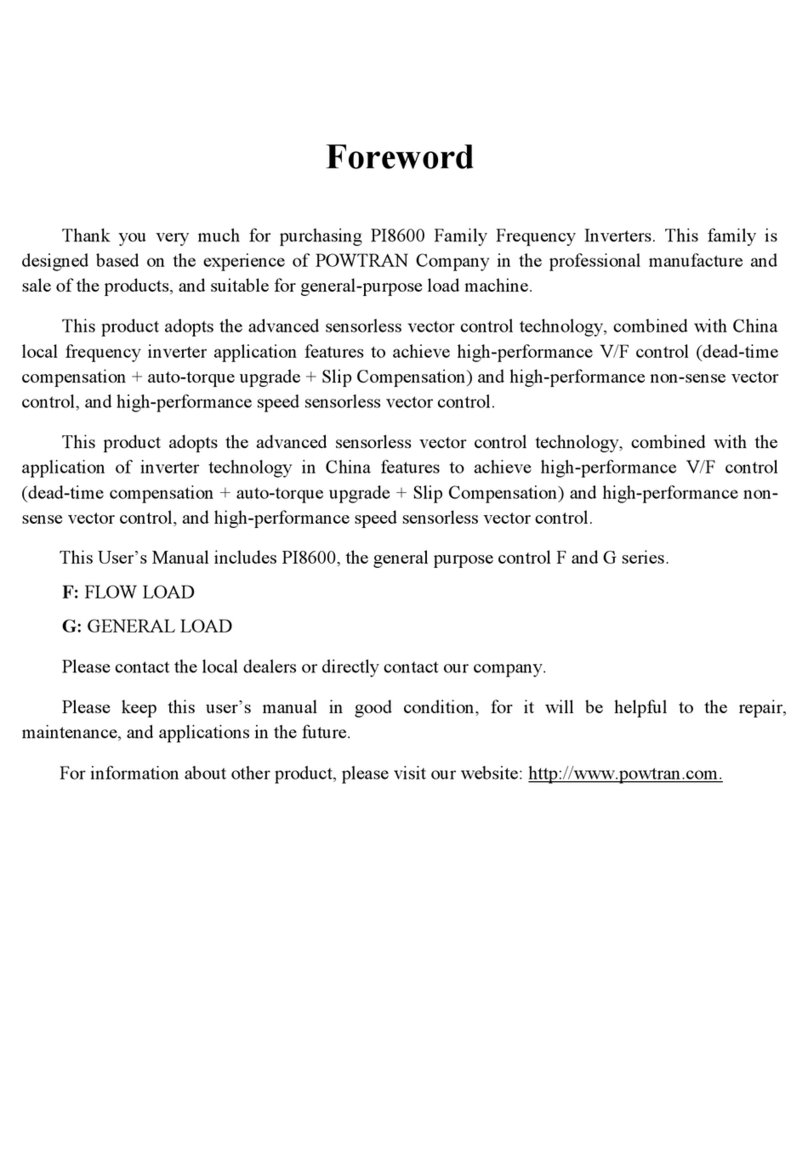
Powtran
Powtran PI8600 Series User manual
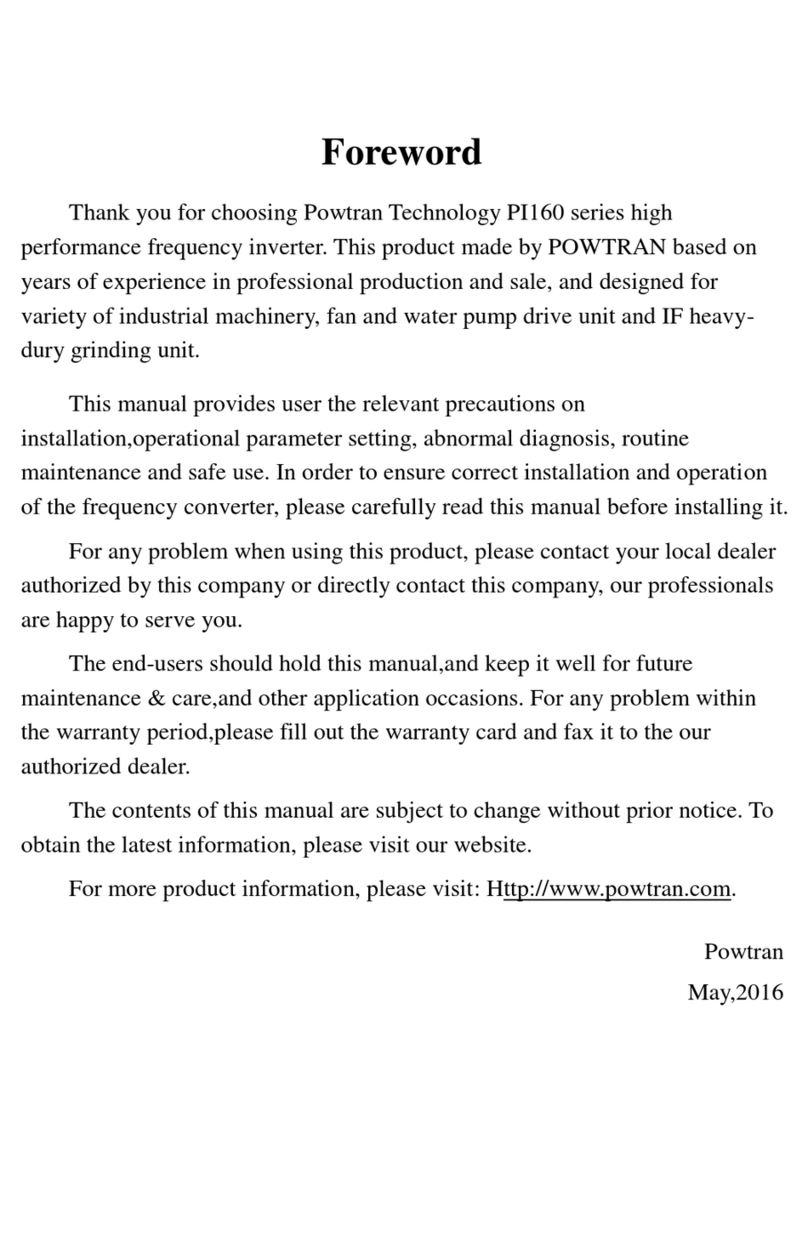
Powtran
Powtran PI160 Series User manual
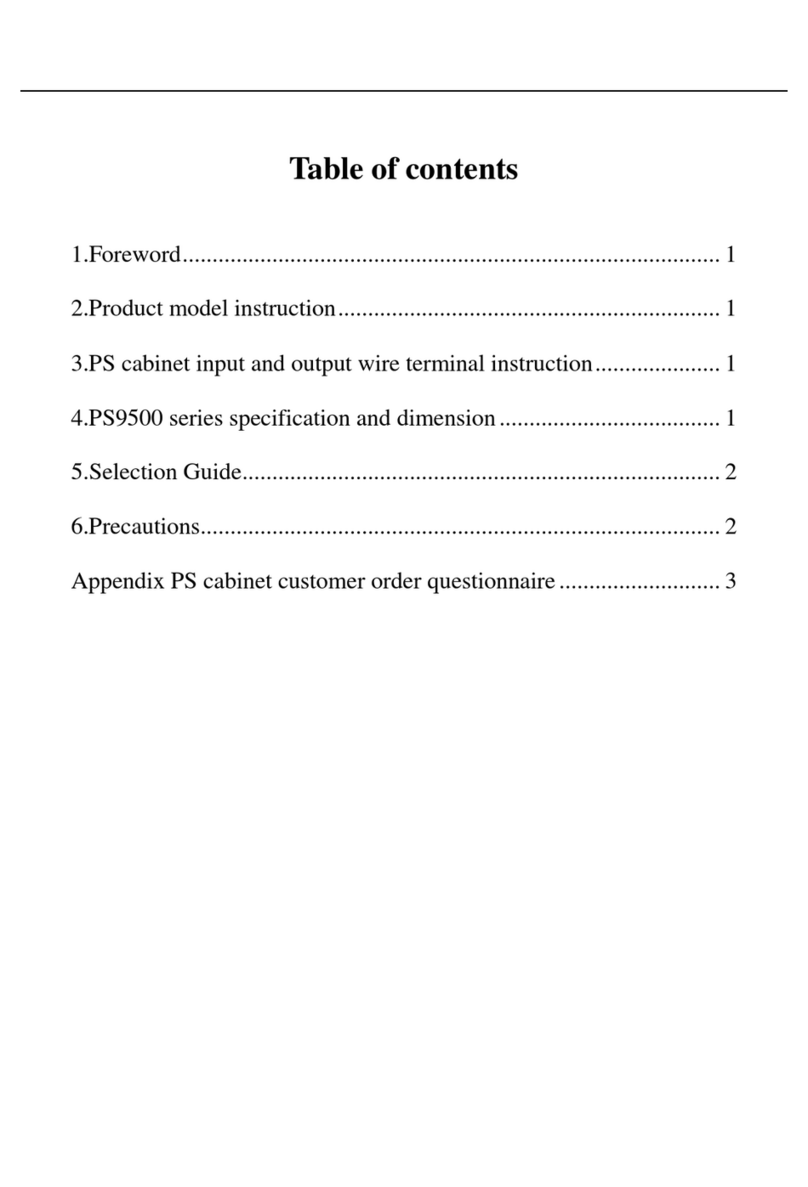
Powtran
Powtran PS9500 Series User manual
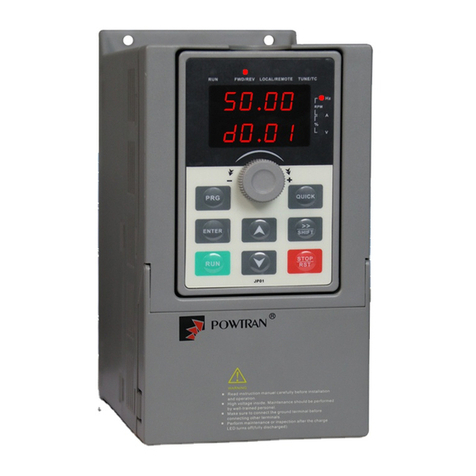
Powtran
Powtran PI500-S Series User manual
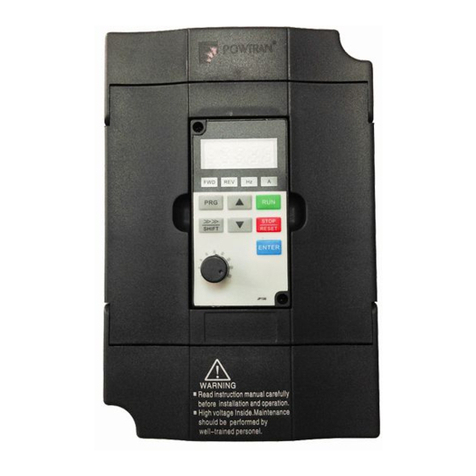
Powtran
Powtran pi130 series User manual
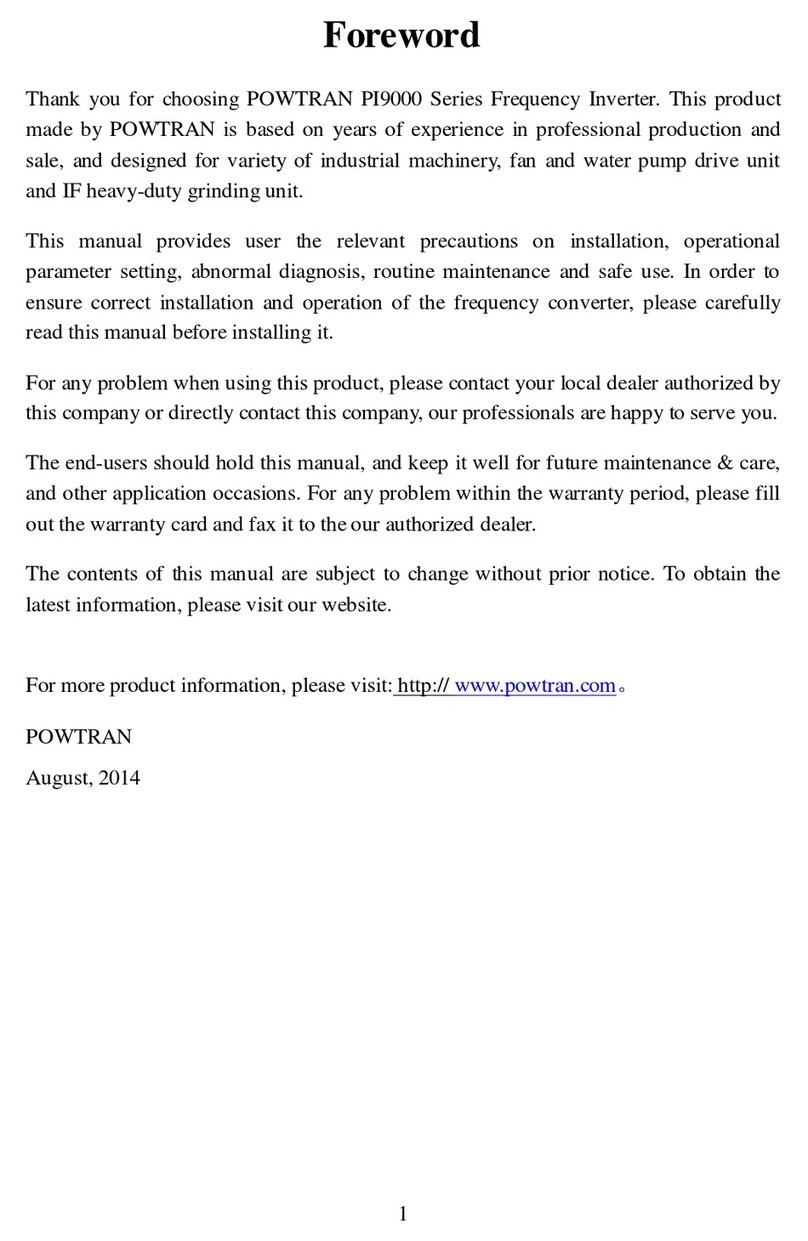
Powtran
Powtran PI9000 series User manual
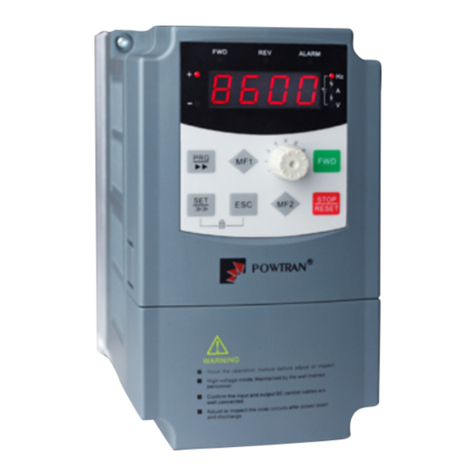
Powtran
Powtran PI8600 F Series User manual

Powtran
Powtran PI7500 Series User manual
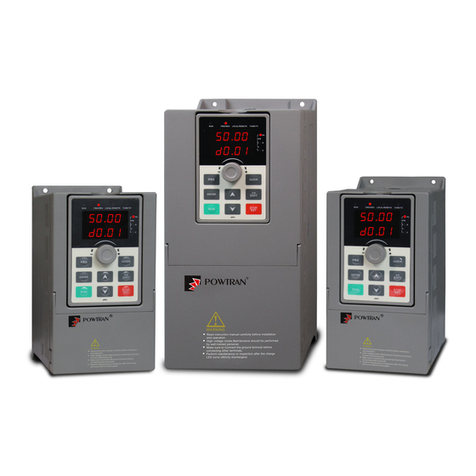
Powtran
Powtran PI500A Series User manual
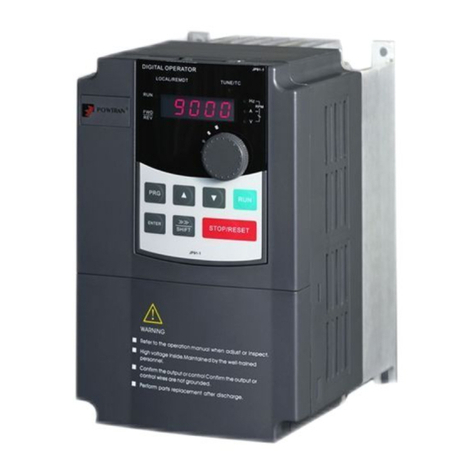
Powtran
Powtran PI9100 Series User manual
